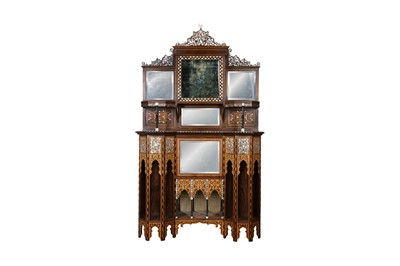28th Oct, 2022 14:00
Islamic & Indian Art
λ A HARDWOOD MOTHER-OF-PEARL AND STAINED WOOD-INLAID ORIENTALIST MIRROR CABINET
Possibly Liberty & Co., London, England, ca. 1880 - 1900
λ A HARDWOOD MOTHER-OF-PEARL AND STAINED WOOD-INLAID ORIENTALIST MIRROR CABINET
Possibly Liberty & Co., London, England, ca. 1880 - 1900
Of typical rectangular shape with protruding sides, resting on bracket feet, divided into two main registers, the bottom designed as two faceted octagonal occasional tables split in half, the leg panels enhanced with cusped arches, the wooden façade inlaid with thin mother-of-pearl tesserae laid out as intricate arabesques and vegetal scrolls, and light coloured and ebonised wood tesserae as fretwork bands, the lower unit with a frieze of three arches, the central vertical section with three rectangular mirrors and two more mirrors to the sides of the upper unit, between them a teal-coloured velvet-lined glass cabinet, framed by coloured woods and mother-of-pearl-inlaid zig-zag triangular fretwork band, the sides with raised shelves, crenelated edges and further mother-of-pearl-inlaid vegetal and geometric decorative motifs, supported by carved ebony baluster-shaped columns, the top enhanced with lobed vegetal friezes, volutes and a crescent moon, creating a mother-of-pearl arabesque triumph against a ground of brown wood, approx. 208cm x 122cm x 37.5cm.
Liberty & Co. was a true institution of fashion, decor, and style in late 19th-century England. Its founder, Arthur Lasenby Liberty (1843 - 1917), opened the business selling imported goods from the Near, Middle and Far East, in line with the rising demand for "all things Oriental" flaring up in England towards the end of the 19th century. His department store became a mecca for Pre-Raphaelite artists, inspired and mesmerised by Liberty's selection of Oriental fabrics, unusual Moorish furniture designs, and Asian colourful wares. East India House, the original name of his store located at 218A Regent Street in London, quickly grew into a first-class Oriental bazaar and Arthur Liberty travelled extensively to both secure the best contracts with his international suppliers and also draw inspiration for future lines. As the business prospered, he expanded the store in the late 1870s, moving to 140 - 150 Regent Street, renaming the building Chesham House, and establishing the independent brand of Liberty & Co. His shop featured a furnishing and decorating studio eager to undertake commissions from all over the world for entire houses or individual rooms (Marie-Therese Rieber, Liberty: The History, 2021, pp. 11 - 14)
Under the leadership of Leonard Francis Wyburd (12 June 1865 – 17 January 1958), a British painter, interior and furniture designer, and appointed Head of Liberty's Furnishing and Decoration Studio from 1883 until 1903, the department store spearheaded a large production of Hispano-Moresque, Ottoman and Islamic-influenced furniture designs, which proved to be both fashionable and popular. In the early 1880s, only a few articles were available and they were mainly imported from Turkey and Cairo, Egypt (Stephen Astley in The House of Liberty: Masters of Style and Decoration, 1992, p. 74). But under Wyburd's direction, Liberty furniture evolved rapidly and it was not long before the first line of British-manufactured Moorish-inspired works was launched. Particularly captivated by the shapes and dense patterns of Middle Eastern furniture, Wyburd developed his own adaptation of Arabian art. In his creations, he started employing wooden mashrabiya latticework, elegant mother-of-pearl marquetry works, arabesque and floral decorative motifs, crenelated edges and miniaturised architectural elements like lobed niches, cusped arches and thin columns, all inspired from Islamic buildings, and wisely blending them into traditional pieces of British furniture such as cabinets, stools, tea tables and settees (Marie-Therese Rieber, Liberty: The History, 2021, p. 58). Despite the lack of a Liberty & Co. stamp or label, our mirror cabinet presents several of the decorative and artistic qualities of the production spearheaded by Wyburd, indicating a strong connection with the British brand and its late 19th-centuries designs.
For further examples of Orientalist furniture commissioned by Liberty and Co., London, please see J. Sweetman, The Oriental Obsession: Islamic Inspiration in British And American Art And Architecture 1500-1920, fig. 115, p. 188; and Daryl Bennett, Liberty's Furniture 1875 - 1915: The Birth of Modern Interior Design, 2012, figs. 3.14, 3.26 - 27, and 3.46.
This item may require Export or CITES licences in order to leave the UK or the European Union. It is the buyer's responsibility to ensure that lots have the relevant licences before shipping.
Sold for £3,500
Includes Buyer's Premium
Do you have an item similar to the item above? If so please click the link below to submit a free online valuation request through our website.





